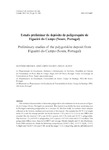Mostrar o rexistro simple do ítem
Estudo preliminar do depósito de paligorsquite de Figueiró do Campo (Soure, Portugal)
| dc.contributor.author | Moura, António | es_ES |
| dc.contributor.author | Lopes Velho, José | es_ES |
| dc.contributor.author | Alves, Willy | es_ES |
| dc.date.accessioned | 2015-07-06T11:16:32Z | |
| dc.date.available | 2015-07-06T11:16:32Z | |
| dc.date.issued | 2015 | es_ES |
| dc.identifier.citation | Cadernos Laboratorio Xeolóxico de Laxe, 2015, 38: 95-108 ISSN:0213-4497 | es_ES |
| dc.identifier.issn | 0213-4497 | es_ES |
| dc.identifier.uri | http://hdl.handle.net/2183/14754 | |
| dc.description.abstract | [Abstract]The technical characteristics of miocenic palygorskite rich-sediments from an area near Figueiró do Campo (Soure, Portugal) are presented. The deposit is probably the most promising area in Portugal concerning palygorskite as a resource. In this first study we evaluate three samples collected in the bottom, medium and top levels of the deposit. The samples has 58-79 % in weight under 63 μ and the average particle size in the fraction < 63 μ has 0.2 to 2.2 μ in size. DRX data revealed that the fraction < 63 μ are 26-34 % quartz, 4-6 % Fe oxide and 61-70 % palygorskite. The fraction < 2 μ is 89-93 % palygorskite, 4-8 % quartz, 3-4 % Fe oxide and 0-3 % caolinite. The palygorskite fibbers were observed in MEV and average 344 nm (length) and 31 nm (thickness). From FRX analysis we obtain the following compositions: 69-60 % SiO2, 11-17 % Al2O3, 7.5-5.1 % MgO and 3.6-6.6 % Fe total. CTC are in the range 7.2-11.2 meq/100g, and the pH between 6.0 94 António Moura, José Lopes Velho e Willy Alves CAD. LAB. XEOL. LAXE 38 (2015) and 7.1. The moisture are between 9.21 and 15.08 %. Oil and water sorption are respectively in the range 69-100 % and 75-134 %. Einlehner abrasivity is between 11 and 80 mg in the fraction < 63 μ, and 1.2- 1.9 mg in the fraction < 2 μ.In the overall results do not exclude the possibility of a feasible exploitation. It is thus essential to proceed with a geophysical study (to determine the thickness and form of the deposit) and with boreholes exploration in order to get fresh samples from the interior of the mineralized level. The deposit was probably formed in a restricted basin filled with alkaline waters and the palygorskite precipitated from solutions satured with silica and magnesium although we cannot preclude a formation after an esmectite precursor. | es_ES |
| dc.language.iso | por | es_ES |
| dc.publisher | Universidade da Coruña | es_ES |
| dc.subject | Palygorskite | es_ES |
| dc.subject | Deposit | es_ES |
| dc.subject | Portugal | es_ES |
| dc.title | Estudo preliminar do depósito de paligorsquite de Figueiró do Campo (Soure, Portugal) | es_ES |
| dc.title.alternative | Preliminary studies of the palygorskite deposit from Figueiró do Campo (Soure, Portugal) | es_ES |
| dc.type | info:eu-repo/semantics/article | es_ES |
| dc.rights.access | info:eu-repo/semantics/openAccess | es_ES |






